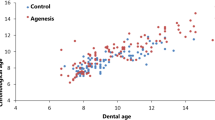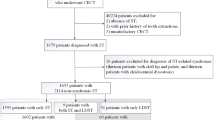Abstract
Objective
Development of human dentition has been used as a predictor for evaluating the growth and maturity of an individual. It is fairly identical in a specific population, but the effect of development on subjects with dental anomalies had not been fully explored, particularly on subjects with supernumerary teeth (ST). This study hence aims to evaluate the dental development of children with and without ST.
Materials and methods
Sample size calculation was conducted and 320 radiographs of subjects with and without supernumerary teeth (ST) were obtained from the archives of a teaching hospital. The subjects in both groups were age and sex matched. All the subjects belong to southern Chinese ethnicity aged 2 to 14 years. The left-side dentition was scored, and dental age (DA) was estimated by obtaining scores from the southern Chinese dental reference dataset. Paired t test was used to calculate the difference between chronological age and dental age (CA-DA) for boys and girls with and without ST and further based on the number and position of ST.
Results
The difference between chronological age and dental age (CA-DA) was 0.10 years for boys and 0.19 years for girls with ST whilst 0.01 and 0.05 years for boys and girls without ST (p > 0.05). The boys with bilateral ST showed significant delay in dental development of 0.23 years (p < 0.05). Position of the ST did not have any influence on dental age.
Conclusions
No significant difference was observed in the dental development of children with and without supernumerary teeth.
Clinical relevance
Understanding dental development of children with supernumerary teeth may be useful in appropriate treatment planning of such conditions.




Similar content being viewed by others
References
Garn SM, Lewis AB, Kerewsky RS (1965) Size interrelationships of the mesial and distal teeth. J Dent Res 44:350–354
Anderson DL, Thompson GW, Popovich F (1975) Interrelationships of dental maturity, skeletal maturity, height and weight from age 4 to 14 years. Growth 39,:453–462
Jayaraman J, Roberts GJ, King NM, Wong HM (2012) Dental age assessment of southern Chinese using the United Kingdom Caucasian reference dataset. Forensic Sci Int 216:68–72
Omer RS, Anthonappa RP, King NM (2010) Determination of the optimum time for surgical removal of unerupted anterior supernumerary teeth. Pediatr Dent 32:14–20
King NM, Tsai JSJ, Wong HM (2010) Morphological and numerical characteristics of the southern Chinese dentitions. Part I: anomalies in the permanent dentition. Open Anthropology J 3:54–64
Huang WH, Tsai TP, Su HL (1992) Mesiodens in the primary dentition stage: a radiographic study. J Dent Child 59:186–189
Anthonappa RP, Omer RS, King NM (2008) Characteristics of 283 supernumerary teeth in southern Chinese children. Oral Surg Oral Med Oral Pathol Oral Radiol Endod 105:e48–e54
Mallineni SK, Jayaraman J, Yiu CK, King NM (2012) Concomitant occurrence of hypohyperdontia in a patient with Marfan syndrome: a review of the literature and report of a case. J Investig Clin Dent 3:253–257
Liversidge HM, Kosmidou A, Hector MP, Roberts GJ (2005) Epidermolysisbullosa and dental developmental age. Int J Paediatr Dent 15:335–341
Jaffe EC, Roberts GJ, Chantler C, Carter JE (1990) Dental maturity in children with chronic renal failure assessed from dental panoramic tomographs. J Int Assoc Dent Child 20:54–58
Primosch RE (1980) Dental and skeletal maturation in patients with cystic fibrosis. J Oral Med 35:7–13
Dahllof G, Nasman M, Borgstrom A, Modeer T (1989) Effect of chemotherapy on dental maturity in children with hematological malignancies. Pediatr Dent 11:303–306
Lai MC, King NM, Wong HM (2008) Dental development of Chinese children with cleft lip and palate. Cleft Palate Craniofac J 45:289–296
Sajnani A, King N (2010) Dental age of children and adolescents with impacted maxillary canines. J Orofac Orthop73: 359–364
Rozylo-Kalinowska I, Kolasa-Raczka A, Kalinowski P (2011) Dental age in patients with impacted maxillary canines related to the position of the impacted teeth. Eur J Orthod 33:492–497
Demirijian A, Goldstein H, Tanner JM (1973) A new system of dental age assessment. Hum Biol 45:211–227
Roberts GJ, Parekh S, Petrie A, Lucas VS (2008) Dental age assessment (DAA): a simple method for children and emerging adults. Br Dent J 204:E7
Jayaraman J, Wong HM, King NM, Roberts GJ (2016) Development of a reference data set (RDS) for dental age estimation (DAE) and testing of this with a separate validation set (VS) in a southern Chinese population. J Forensic Legal Med 43:26–33
Landis JR, Koch GG (1977) The measurement of observer agreement for categorical data. Biometrics 33:159–174
Anthonappa RP, King NM, Rabie AB, Mallineni SK (2012) Reliability of panoramic radiographs for identifying supernumerary teeth in children. Int J Paediatr Dent 22:37–43
Mallineni SK, Anthonappa RP, King NM (2016) Reliability of horizontal and vertical tube shift techniques in the localisation of supernumerary teeth. Eur Arch Paediatr Dent 17:455–460
Jain S, Shetty KS, Jain S, Jain S, Prakash AT, Agrawal M (2015) Evaluation of dental age and associated developmental anomalies in subjects with impacted mandibular canines. Angle Orthod 85:638–644
Townsend G, Harris EF, Lesot H, Clauss F, Brook A (2009) Morphogenetic fields within the human dentition: a new, clinically relevant synthesis of an old concept. Arch Oral Biol 54:S34–S44
Jayaraman J, Roberts G (2016) Demirjian’s method is unsuitable for dental age estimation. Forensic Sci Med Pathol 12:532–533
Quaremba G, Buccelli C, Graziano V, Laino A, Laino L, Paternoster M, Petrone P (2018) Some inconsistencies in Demirjian’s method. Forensic Sci Int 283:190–199
Jayaraman J, King NM, Roberts GJ, Wong HM (2011) Dental age assessment: are Demirjian’s standards appropriate for southern Chinese children? J Forensic Odontostomatol 29:22–28
Brook AH, Elcock C, Al-Sharood MH, McKeown HF, Khalaf K, Smith RN (2002) Further studies of a model for the etiology of anomalies of tooth number and size in humans. Connect Tissue Res 43:289–295
Brook AH, Griffin RC, Smith RN, Townsend GC, Kaur G, Davis GR, Fearne J (2009) Tooth size patterns in patients with supernumerary teeth and hypodontia. Arch Oral Biol 54:S63–S70
Khalaf K, Robinson DL, Elcock C, Smith RN, Brook AH (2005) Tooth size in patients with supernumerary teeth and a control group measured by an image analysis system. Arch Oral Biol 50:243–248
Badrov J, Lauc T, Nakaš E, Galić I (2017) Dental age and tooth development in orthodontic patients with agenesis of permanent teeth. Biomed Res Int 2017:8683970
Acknowledgements
The authors would like to thank Professor Graham Roberts at King’s College London Dental Institute who helped in the preparation of southern Chinese dental reference dataset employed in this study.
Funding
The work described in this paper was fully supported by a grant from the Research Grants Council of the Hong Kong Special Administrative Region, China (Project No. 17126115).
Author information
Authors and Affiliations
Corresponding author
Ethics declarations
Conflict of interest
The authors declare that they have no conflict of interest.
Ethical approval
Ethics approval for this study was obtained from the Institutional Review Board of the University of Hong Kong (Reference Number UW 12-280). All procedures performed in studies involving human participants were in accordance with the ethical standards of the institutional and/or national research committee and with the 1964 Helsinki declaration and its later amendments or comparable ethical standards.
Informed consent
For this type of study, formal consent is not required.
Rights and permissions
About this article
Cite this article
Mallineni, S.K., Jayaraman, J., Wong, H.M. et al. Dental development in children with supernumerary teeth in the anterior region of maxilla. Clin Oral Invest 23, 2987–2994 (2019). https://doi.org/10.1007/s00784-018-2709-2
Received:
Accepted:
Published:
Issue Date:
DOI: https://doi.org/10.1007/s00784-018-2709-2




